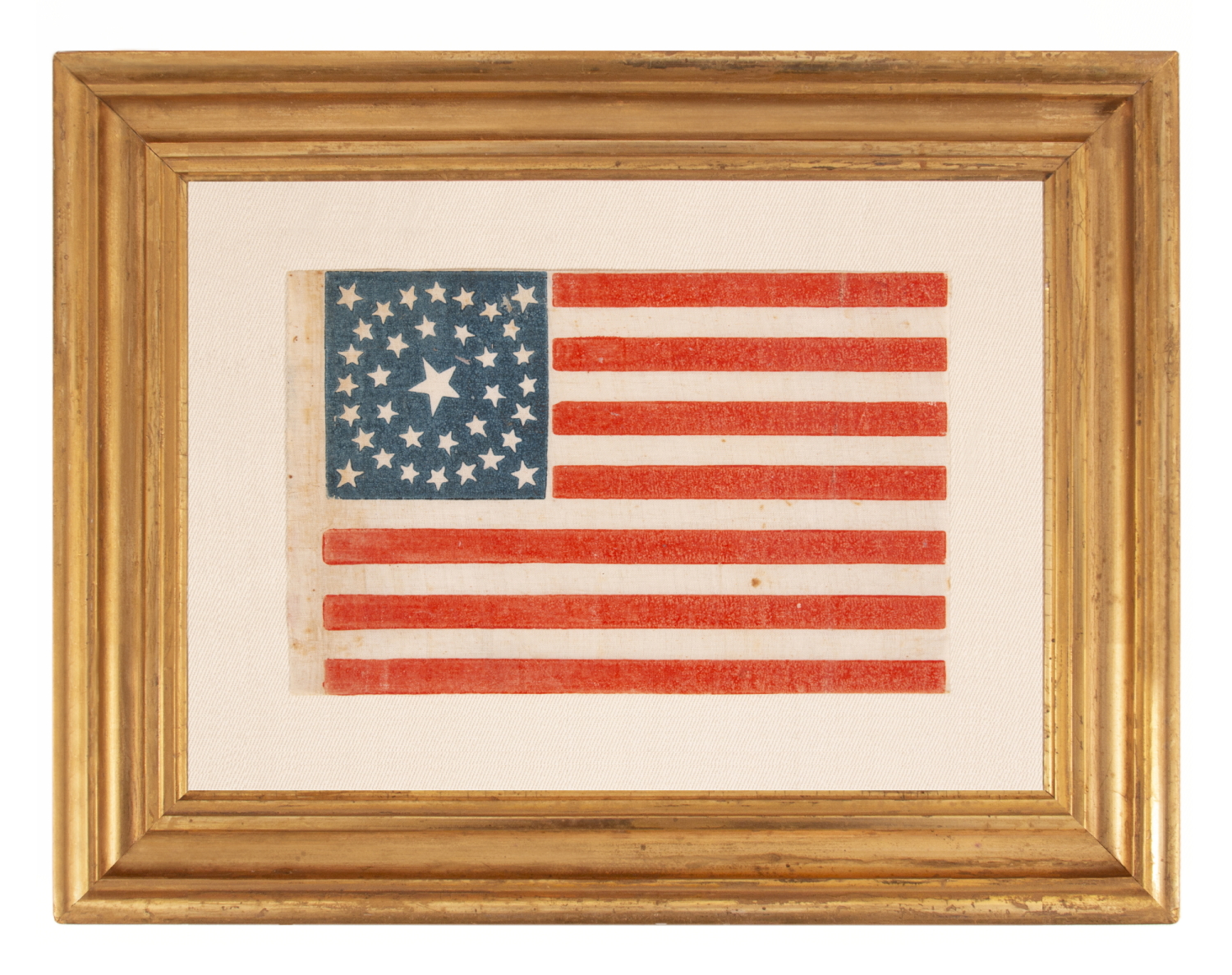


| 35 STAR ANTIQUE AMERICAN PARADE FLAG WITH A DOUBLE-WREATH STYLE MEDALLION CONFIGURATION OF STARS, PERHAPS THE BEST SURVIVING EXAMPLE IN THIS RARE FORM, CIVIL WAR PERIOD, WEST VIRGINIA STATEHOOD, 1863-1865 |
|
| Web ID: | 35-004 |
| Available: | In Stock |
| Frame Size (H x L): | Approx. 14.5" x 18.25" |
| Flag Size (H x L): | 6.5" x 10.25" |
| Description: | |
| 35 star American national flag, block-printed on glazed cotton. The stars are arranged in circular medallion that consists of a large center star, surrounding by two wreaths of much smaller stars, with a flanking star, of an in between size, in each corner of the canton. Note the whimsical, folk qualities, present not only in the crude shapes of the stars themselves, but in their vertical alignment. Spun in various directions on their vertical axis, the canted position of the center star punctuates the flag’s intriguing graphics. West Virginia joined the Union as the 35th state on June 20th, 1863, annexed from the upper west corner of Virginia to become a Free State, just 10 days before the Battle of Gettysburg. The 35 star flag became official on Independence Day of that year, one day after the battle’s conclusion. On the very same day, an event of equivalent importance took place in Mississippi, when Confederate General John C. Pemberton surrendered to Union General Ulysses S. Grant, as the city of Vicksburg fell in the heart of the Confederacy. While the 35 star flag remained official until July 3rd, 1865, production would have ceased long before. Nevada became the 36th state on October 31st, Halloween, 1864, ushered in by Lincoln just 8 days before his reelection. The makers of American flags, both commercial and private, paid little heed to official guidelines with regard to official specifications, often adding stars before the respective states were even in, in hopeful anticipation of their arrival, or subtracting whatever number they felt were loyal to the Southern cause. Not wanting to produce flags that would soon be out-of-date, most flag-makers would have included a 36th star upon Nevada’s admission. This meant that 35 star flags were realistically produced for less than a year-and-a-half. Scarcity is one reason why 35 star flags are so interesting. Far fewer flags are known in this count than in the 34 star count that proceeded it, or the 36 star count that followed. Among the 35 star parade flags known to exist in this particular style, this may be the best of all known examples, due to both its strong colors, with an interesting shade of ocean blue that contrasts beautifully with a vibrant sunfire red, and the grainy qualities of its printing, which is particularly appealing from the perspective serious collectors of Americana, who appreciate exceptional early surfaces on paint decorated objects. Because there was no official star pattern until 1912, the design of the American flag in the 19th century was left to the whims of its maker. The liberties afforded to Americans in the rendering of the Stars & Stripes during the 18th and 19th centuries explains some of them can be counted among the best examples of Early American folk art. Mounting: The flag was mounted and framed within our own conservation department, which is led by expert staff. We take great care in the mounting and preservation of flags and have framed thousands of examples. The flag has been hand-stitched to a background of 100% hemp fabric, ivory in color, with a twill weave. The gilded American molding dates to the mid-19th century. Spacers keep the textile away from the glass, which is U.V. protective. Condition: there is modest-moderate soiling along the hoist, running into the last three white stripes and a bit into the Canton. There are a few tiny stains in the striped field, the most significant of which is in the 5th white stripe, about 2/3 of the way across. There is minor misprinting in the canton. Many of my clients prefer early flags to show their age and history of use. |
|
| Video: | |
| Collector Level: | Advanced Collectors and the Person with Everything |
| Flag Type: | Parade flag |
| Star Count: | 35 |
| Earliest Date of Origin: | 1863 |
| Latest Date of Origin: | 1865 |
| State/Affiliation: | West Virginia |
| War Association: | 1861-1865 Civil War |
| Price: | Please call (717) 676-0545 or (717) 502-1281 |
| E-mail: | info@jeffbridgman.com |
 |
|